Sloth bear
The sloth bear (Melursus ursinus) is a myrmecophagous bear species native to the Indian subcontinent. It feeds on fruits, ants and termites. It is listed as Vulnerable on the IUCN Red List, mainly because of habitat loss and degradation.[1]
| Sloth bear Temporal range: Late Pliocene to Early Pleistocene – recent | |
|---|---|
| A sloth bear in the National Zoo in Washington, D.C. | |
| Scientific classification | |
| Kingdom: | Animalia |
| Phylum: | Chordata |
| Class: | Mammalia |
| Order: | Carnivora |
| Family: | Ursidae |
| Subfamily: | Ursinae |
| Genus: | Melursus Meyer, 1793 |
| Species: | M. ursinus |
| Binomial name | |
| Melursus ursinus (Shaw, 1791) | |
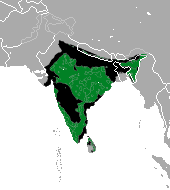 | |
| Sloth bear range (black – former, green – extant) | |
| Synonyms | |
| |
It has also been called "labiated bear" because of its long lower lip and palate used for sucking insects.[2] It has a long, shaggy fur, a mane around the face, and long, sickle-shaped claws. It is lankier than brown and Asian black bears. It shares features of insectivorous mammals and evolved during the Pleistocene from the ancestral brown bear through convergent evolution.
Sloth bears breed during spring and early summer and give birth near the beginning of winter. When their territories are encroached upon by humans, they sometimes attack them. Historically, humans have drastically reduced their habitat and diminished their population by hunting them for food and products such as their bacula and claws. Sloth bears have been tamed and used as performing animals and as pets.[3]
Taxonomy
Shaw in 1791 named the species Bradypus ursinus. In 1793, Meyer named it Melursus lybius, and in 1817, de Blainville named it Ursus labiatus because of its long lips. Illiger named it Prochilus hirsutus, the Greek genus name indicating long lips, while the specific name noted its long and coarse hair. Fischer called it Chondrorhynchus hirsutus, while Tiedemann named it Ursus longirostris.[4]
Subspecies and range
| Name | Description | Distribution |
|---|---|---|
| Indian sloth bear (Melursus ursinus ursinus) (Shaw, 1791) |
This is the nominate subspecies and has a large skull with a condylobasal length of about 290 mm (11 in) in females and about 310 mm (12 in) in males.[5] | The sloth bear is the most widespread bear species in India, where it mostly occurs in areas with forest cover, low hills bordering the outer range of the Himalayas from Punjab to Arunachal Pradesh. It is absent in the high mountains of Himachal Pradesh and Jammu and Kashmir, the northwestern deserts of Rajasthan, and a broad unforested swath in the south, where Mount Abu Wildlife Sanctuary[6] is located. Sloth bear occurs in protected areas such as Shoolpaneshwar, Ratanmahal, Jessore,[7] and Balaram Ambaji Sanctuaries.[8][9] |
Sri Lankan sloth bear (Melursus ursinus inornatus) Pucheran, 1855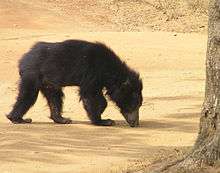 |
The Sri Lankan sloth bear is smaller than the nominate subspecies, has a smaller skull with a condylobasal length of about 250 mm (9.8 in) in females and about 264 mm (10.4 in) in males.[5] It has much shorter body hair, and sometimes lacks the characteristic white chest mark.[11] | At the turn of the century, the Sri Lankan sloth bear occurred throughout Sri Lanka. But due to wide-scale conversion of upland forests into tea and coffee plantations, it is now restricted to the northern and eastern lowlands.[12] |
Evolution
Sloth bears may have reached their current form in the Early Pleistocene, the time when the bear family specialised and dispersed. A fragment of fossilised humerus from the Pleistocene, found in Andhra Pradesh's Kurnool Basin is identical to the humerus of a modern sloth bear. The fossilised skulls of a bear once named Melursus theobaldi found in the Shivaliks from the Early Pleistocene or Early Pliocene are thought by certain authors to represent an intermediate stage between sloth bears and ancestral brown bears. M. theobaldi itself had teeth intermediate in size between sloth bears and other bear species, though its palate was the same size as the former species, leading to the theory that it is the sloth bear's direct ancestor. Sloth bears probably arose during the Middle Pliocene and evolved in the Indian subcontinent. The sloth bear shows evidence of having undergone a convergent evolution similar to that of other ant-eating mammals.[11]
Characteristics
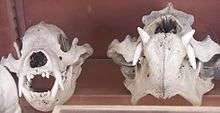
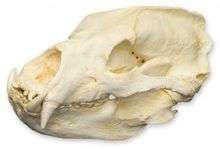
Sloth bears adults are a medium-sized species though weight can range variously from 55 to 105 kg (121 to 231 lb) in typically-sized females and from 80 to 145 kg (176 to 320 lb) in typically-sized males. Exceptionally large specimens of females can scale up to 124 kg (273 lb) and males up to 192 kg (423 lb).[13][14][15][16] The average weight of sloth bears from the nominate subspecies in Nepal was 95 kg (209 lb) in females and 114 kg (251 lb) in males.[17] Nominate bears in India were found to weigh average 93.2 kg (205 lb) in males and 83.3 kg (184 lb) per one study.[18] Specimens from Sri Lanka (M. u. inornatus) may weight up to 68.2 kg (150 lb) in females and 104.5 kg (230 lb) in males.[19] However six Sri Lankan male sloth bears averaged only 74.8 kg (165 lb) and 57.5 kg (127 lb) was the average for four females, so Sri Lankan bears could be up to at least 30% lighter in body mass than nominate race bears and with apparent far more pronounced size sexual dimorphism.[19][20] They are 60–92 cm (2 ft 0 in–3 ft 0 in) high at the shoulder, and have a body length of 1.4–1.9 m (4 ft 7 in–6 ft 3 in).[21][22][23][24][25] Besides being smaller than males, females reportedly typically have more fur between their shoulders.[26]

Sloth bear muzzles are thick and long, with small jaws and bulbous snouts with wide nostrils. They have long lower lips which can be stretched over the outer edge of their noses, and lack upper incisors, thus allowing them to suck up large numbers of insects. The premolars and molars are smaller than in other bears, as they do not chew as much vegetation. In adults, the teeth are usually in poor condition, due to the amount of soil they suck up and chew when feeding on insects.[21] The back of the palate is long and broad, as is typical in other ant-eating mammals.[11] The paws are disproportionately large, and have highly developed, sickle-shaped, blunt claws which measure 10 cm (4 in) in length. Their toe pads are connected by a hairless web. They have the longest tail in the bear family, which can grow to 15–18 cm (6–7 in).[21] Their back legs are not very strong, though they are knee-jointed, and allow them to assume almost any position.[26] The ears are very large and floppy. The sloth bear is the only bear with long hair on its ears.[7]

Sloth bear fur is completely black (rusty for some specimens), save for a whitish Y- or V-shaped mark on the chest.[21] This feature is sometimes absent, particularly in Sri Lankan specimens.[11] This feature, which is also present in Asian black bears and sun bears, is thought to serve as a threat display, as all three species are sympatric with tigers (tigers usually do not carry out attacks on an adult bear if the bear is aware or facing the cat).[11] The coat is long, shaggy, and unkempt, despite the relatively warm environment in which the species is found, and is particularly heavy behind the neck and between the shoulders, forming a mane which can be 30 cm (12 in) long.[11][21] The belly and underlegs can be almost bare. Sloth bears are usually about the same size as an Asian black bear but are immediately distinctive for their shaggier coat, whitish claws, as well as their typically rangier build. Their head and mouth is highly distinct from that of a black bear with a longer, narrower skull shape (particularly the snout), loose-looking, flappier lips and paler muzzle colour. In few areas of overlap, sloth bear confusion with sun bears is unlikely, given the latter species considerably smaller size, much shorter fur, wrinkled folding skin (especially around the back), bolder chest marking and drastically different, more compact head structure and appearance.[25][27]
Distribution and habitat
The sloth bear's global range includes India, the southern lowlands of Nepal, and Sri Lanka. It is regionally extinct in Bangladesh. It occurs in a wide range of habitats including wet and dry tropical forests, savannahs, scrublands, and grasslands below 1,500 m (4,900 ft) on the Indian subcontinent, and below 300 m (980 ft) in Sri Lanka's dry forests.[1]
Behaviour and ecology
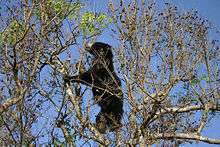
Adult sloth bears may travel in pairs. Males are often observed to be gentle with cubs. They may fight for food. They walk in a slow, shambling motion, with their feet being set down in a noisy, flapping motion. They are capable of galloping faster than running humans.[28] Although they appear slow and clumsy, both young and adult sloth bears are excellent climbers.[29] They occasionally will climb to feed and to rest, though not to escape enemies, as they prefer to stand their ground. Sloth bear mothers carry their cubs up trees as the primary defense against attacks by predators instead of sending them up trees. The cubs can be threatened by predators such as tigers, leopards, and other bears.[30] They are adequate climbers on more accessible trees but cannot climb as quickly or on as varied surfaces as can black bears due to the sloth species' more elongated claw structure. Given their smaller size and still shorter claws, sloth bear cubs probably climb more proficiently than adults (much as brown bear cubs can climb well but not adults).[21] They are good swimmers, and primarily enter water to play.[21] To mark their territories, sloth bears scrape trees with their forepaws, and rub against them with their flanks.[28] Sloth bears have a great vocal range. Gary Brown, in his Great Bear Almanac, lists over 25 different sounds in 16 different contexts. Sounds such as barks, screams, grunts, roars, snarls, whickers, woofs, and yelps are made when angered, threatening, or when fighting. When hurt or afraid, they shriek, yowl, or whimper. When feeding, sloth bears make loud huffing and sucking noises,[28] which can be heard over 100 m away.[21] Sounds such as gurgling or humming are made by bears resting or sucking their paws. Sows emit crooning sounds to their cubs. The species is the most vociferous when mating, and make loud, melodious calls when doing so. Sloth bears do not hibernate. They make their day beds out of broken branches in trees, and rest in caves during the wet season. Sloth bears are the most nocturnal of bears, though sows become more active in daytime when with cubs.[28]
Reproduction

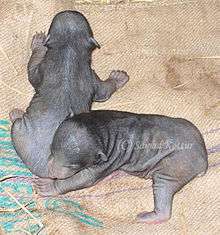
The breeding season for sloth bears varies according to location: in India, they mate in April, May, and June, and give birth in December and early January, while in Sri Lanka, it occurs all year. Sows gestate for 210 days, and typically give birth in caves or in shelters under boulders. Litters usually consist of one or two cubs, or rarely three.[28] Cubs are born blind, and open their eyes after four weeks.[31] Sloth bear cubs develop quickly compared to most other bear species: they start walking a month after birth, become independent at 24–36 months, and become sexually mature at the age of three years. Young cubs ride on their mother's back when she walks, runs, or climbs trees until they reach a third of her size. Individual riding positions are maintained by cubs through fighting. Intervals between litters can last two to three years.[28]
Dietary habits
Sloth bears are expert hunters of termites and ants, which they locate by smell.[28] On arriving at a mound, they scrape at the structure with their claws till they reach the large combs at the bottom of the galleries, and disperse the soil with violent puffs. The termites are then sucked up through the muzzle, producing a sucking sound which can be heard 180 m away.[31] Their sense of smell is strong enough to detect grubs 3 ft below ground. Unlike other bears, they do not congregate in feeding groups.[28] Sloth bears may supplement their diets with fruit, plant matter, carrion, and very rarely other mammals. In March and April, they eat the fallen petals of mowha trees and are partial to mangoes, sugar cane, jackfruit, and the pods of the golden shower tree. Sloth bears are extremely fond of honey.[31] When feeding their cubs, sows are reported to regurgitate a mixture of half-digested jack fruit, wood apples, and pieces of honeycomb. This sticky substance hardens into a dark yellow, circular, bread-like mass which is fed to the cubs. This "bear's bread" is considered a delicacy by some of India's natives.[32]
Relationships with other animals
The large canine teeth of sloth bears, relative to both its overall body size and to the size of the canine teeth of other bear species, and the aggressive disposition of sloth bears, may be a defense in interactions with large, dangerous animals, such as the tiger, elephant, and rhinoceros.[33]
Bengal tigers occasionally prey on sloth bears. Tigers usually give sloth bears a wide berth, though some specimens may become habitual bear killers,[34] and it is not uncommon to find sloth bear fur in tiger scats.[35] Tigers typically hunt sloth bears by waiting for them near termite mounds, then creeping behind them and seizing them by the back of their necks and forcing them to the ground with their weight.[36] One tiger was reported to simply break its victim's back with its paw, then wait for the paralysed bear to exhaust itself trying to escape before going in for the kill.[34] When confronted by tigers face to face, sloth bears charge at them, crying loudly. A young or already sated tiger usually retreats from an assertive sloth bear, as the bear's claws can inflict serious wounds, and most tigers end the hunt if the bears become aware of the tiger's presence before the pounce.[36] Sloth bears may scavenge on tiger kills.[37] As tigers are known to mimic the calls of sambar deer to attract them, sloth bears react fearfully even to the sounds made by deer themselves.[36] In 2011, a female bear with cubs was observed to stand her ground and prevail in a confrontation against two tigers (one female, one male) in rapid succession.[38]
Besides tigers there are few predators of sloth bears. However, leopards can also be a threat, as they are able to follow sloth bears up trees.[15] Bear cubs are probably far more vulnerable and healthy adult bears may be avoided by leopards. One leopard killed a three-quarters grown female sloth bear in an apparently lengthy fight that culminated in the trees. Apparently, a sloth bear killed a leopard in a confrontation in Yala National Park, Sri Lanka but was itself badly injured in the fight and was subsequently put down by park rangers.[39][40] Sloth bears occasionally chase leopards from their kills.[28] Dhole packs may attack sloth bears.[41] When attacking them, dholes try to prevent the bear from retreating into caves.[42] Unlike tigers which prey on sloth bears of all size, there is little evidence that dholes are a threat to fully-grown sloth bears other than exceptionally rare cases.[25][43] In one case, a golden jackal (a species much smaller and less powerful than a sloth bear and not generally a pack hunter as is the dhole) was seen to aggressively displace an adult bear which passively loped away from the snapping canid, indicating the sloth bear does not regard other carnivores as competition.[15]
Sloth bears are sympatric with Asiatic black bears in northern India, and the two species, along with the sun bear, coexist in some of the national parks and wildlife sanctuaries. They are also found together in Assam, Manipur, and Mizoram, in the hills south of the Brahmaputra River, the only places occupied by all three bear species. The three species do not act aggressively toward each other. This may be because the three species generally differ in habit and dietary preferences.[15]
Asian elephants apparently do not tolerate sloth bears in their vicinity. The reason for this is unknown, as individual elephants known to maintain their composure near tigers have been reported to charge bears.[31] The Indian rhinoceros has a similar intolerance for sloth bears, and will charge at them.[28]
Status and conservation
IUCN estimates that fewer than 20,000 sloth bears survive in the wilds of the Indian subcontinent and Sri Lanka. The sloth bear is listed in Schedule I of the Indian Wildlife Protection Act, 1972, which provides for their legal protection. International trade of the sloth bear is prohibited as it is listed in Appendix I of the Convention on International Trade in Endangered Species.[1]
To address the human-bear conflict, people may be educated about the conservation ethics, particularly among locals. To resolve this conflict, the basic issue of deteriorating habitat, which is the reason for the conflict between people and bears, improvements through government or community-based reforestation programmes, may be promoted.[1]
The population of sloth bears grows when they live in high-profile reserves that protect species, such as tigers and elephants. Directly managed reserves could conserve the sloth bear, hence such reserves must be supported.[44]
The government of India has banned use of sloth bears for entertainment, and a 'Sloth Bear Welfare Project' in the country has the objective of putting an end to their use for entertainment. However, their number in such activity is still large. Many organisations are helping in the conservation and preservation of sloth bears in safe places. Major sloth bear sanctuaries in India include the Daroji bear sanctuary, Karnataka.[45]
Relationships with humans
Attacks on humans
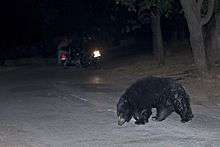
Sloth bears are one of the most aggressive extant bears and, due to large human populations often closely surrounding reserves that hold bears, aggressive encounters and attacks are unfortunately relatively frequent. Going on raw numbers, this is the species of bear that most regularly attacks humans. A single Indian district seems to report a roughly equal number of fatalities for humans each year from sloth bears as do the entire nearly circumpolar range of brown bears. Only the Himalayan black bear subspecies of Asian black bear is nearly as dangerous.[46][47][46] Sloth bears likely view humans as potential predators, as their reactions to them (roaring, followed by retreat or charging) are similar to those evoked in the presence of tigers and leopards.[11] Their long claws, which are ideally adapted for digging at termite mounds, make adults less capable of climbing trees to escape danger, as are other bears such as Asian black bears. Therefore, sloth bears have seemingly evolved to deal with threats by behaving aggressively. For the same reason, brown bears can be similarly inclined, accounting for the relatively high incidence of seemingly nonpredatory aggression towards humans in these two bear species.[48]
According to Robert Armitage Sterndale, in his Mammalia of India (1884, p. 62):
[The sloth bear] is also more inclined to attack man unprovoked than almost any other animal, and casualties inflicted by it are unfortunately very common, the victim being often terribly disfigured even if not killed, as the bear strikes at the head and face. Blanford was inclined to consider bears more dangerous than tigers...
Captain Williamson in his Oriental Field Sports wrote of how sloth bears rarely killed their human victims outright, but would suck and chew on their limbs till they were reduced to bloody pulps.[2] One specimen, known as the sloth bear of Mysore, was responsible for the deaths of 12 people and the mutilation of 24 others. It was shot by Kenneth Anderson.[49] Although sloth bears have attacked humans, they rarely become man-eaters. Dunbar-Brander's Wild Animals of Central India mentions a case in which a sow with two cubs began a six-week reign of terror in Chanda, a district of the Central Provinces, during which more than one of their victims had been eaten,[50] while the sloth bear of Mysore partially ate at least three of its victims.[49] R.G. Burton deduced from comparing statistics that sloth bears killed more people than Asian black bears,[50] and Theodore Roosevelt considered them to be more dangerous than American black bears.[51] Unlike some other bear species, which at times make mock charges at humans when surprised or frightened without making physical contact, sloth bears frequently appear to initiate a physical attack almost immediately. When people living near an aggressive population of sloth bears were armed with rifles, it was found that it was an ineffective form of defense, since the bear apparently charges and knocks the victim back (often knocking the rifle away) before the human has the chance to defend himself.[52][53] In Madhya Pradesh, sloth bear attacks accounted for the deaths of 48 people and the injuring of 686 others between 1989 and 1994, probably due in part to the density of population and competition for food sources.[54] A total of 137 attacks (resulting in 11 deaths) occurred between April 1998 and December 2000 in the North Bilaspur Forest Division of Chhattisgarh. The majority of attacks were perpetrated by single bears, and occurred in kitchen gardens, crop fields, and in adjoining forests during the monsoon season.[55] One Mr. Watts Jones wrote a first-hand account of how it feels to be attacked by a sloth bear, recalling when he failed to score a direct hit against a bear he had targeted:
I do not know exactly what happened next, neither does my hunter who was with me; but I believe, from the marks in the snow, that in his rush the bear knocked me over backwards in fact, knocked me three or four feet away. When next I remember anything, the bear's weight was on me, and he was biting my leg. He bit two or three times. I felt the flesh crush, but I felt no pain at all. It was rather like having a tooth out with gas. I felt no particular terror, though I thought the bear had got me; but in a hazy sort of way I wondered when he would kill me, and thought what a fool I was to get killed by a stupid beast like a bear. The shikari then very pluckily came up and fired a shot into the bear, and he left me. I felt the weight lift off me, and got up. I did not think I was much hurt. ... The main wound was a flap of flesh torn out of the inside of my left thigh and left hanging. It was fairly deep, and I could see all the muscles working underneath when I lifted it up to clean the wound."[56]
In 2016, according to a forest official, a female bear had killed three people, and hurt five others in Gujarat State's Banaskantha district, near Balaram Ambaji Wildlife Sanctuary, with some of the casualties being colleagues. At first, an attempt was made to trace and cage it, but this failed, costing the life of one official, and so a team of both officials and policemen shot the bear.[9]
In Karnataka's Bellary district, most of the attacks by sloth bears occurred outside forests, when they entered settlements and farmlands in search of food and water.[57]
Hunting and products
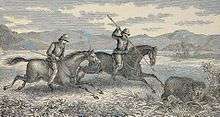
One method of hunting sloth bears involved the use of beaters, in which case, a hunter waiting on a post could either shoot the approaching bear through the shoulder or on the white chest mark if it was moving directly to him. Sloth bears are very resistant to body shots, and can charge hunters if wounded, though someone of steady nerves could score a direct hit from within a few paces of a charging bear. Sloth bears were easy to track during the wet season, as their clear footprints could be followed straight to their lairs. The majority of sloth bears killed in forests were due to chance encounters with them during hunts for other game. In hilly or mountainous regions, two methods were used to hunt them there. One was to lie in wait above the bear's lair at dawn and wait for the bear to return from its nocturnal foraging. Another was to rouse them at daytime by firing flares into the cave to draw them out.[58] Sloth bears were also occasionally speared on horseback.[7] In Sri Lanka, the baculum of a sloth bear was once used as a charm against barrenness.[26]
Tameability
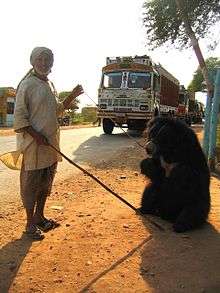
Officers in British India often kept sloth bears as pets.[31] The wife of Kenneth Anderson kept an orphaned sloth bear cub from Mysore, which she named "Bruno". The bear could be fed on almost anything (including motor oil) and was very affectionate toward people. It was even taught numerous tricks, such as cradling a woodblock like a baby or pointing a bamboo stick like a gun.[59]
Dancing bears were historically a popular entertainment in India, dating back to the 13th century and the pre-Mughal era. The Kalandars, who practised the tradition of capturing sloth bears for entertainment purposes, were often employed in the courts of Mughal emperors to stage spectacles involving trained bears.[31] They were once common in the towns of Calcutta, where they often disturbed the horses of British officers.[31]
Despite a ban on the practice that was enacted in 1972, as many as 800 dancing bears were in the streets of India during the latter part of the 20th century, particularly on the highway between Delhi, Agra, and Jaipur. Sloth bear cubs, which were usually purchased at the age of six months from traders and poachers, were trained to dance and follow commands through coercive stimuli and starvation. Males were castrated at an early age, and their teeth were knocked out at the age of one year to prevent them from seriously injuring their handlers. The bears were typically fitted with a nose ring attached to a four-foot leash. Some were found to be blind from malnutrition.[60]
In 2009, following a seven-year campaign by a coalition of Indian and international animal welfare groups, the last Kalandar dancing bear was set free.[61] The effort to end the practice involved helping the bear handlers find jobs and education, which enabled them to reduce their reliance on dancing-bear income.[62]
Cultural references
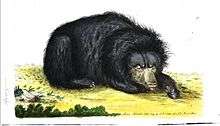
Charles Catton included the bear in his 1788 book Animals Drawn from Nature and Engraved in Aqua-tinta, describing it as an "animal of the bear-kind" and saying it was properly called the "Petre Bear".[63]
In Rudyard Kipling's The Jungle Book, Baloo "the sleepy old brown bear" teaches the Law of the Jungle to the wolf cubs of the Seeonee wolf pack, as well as to his most challenging pupil, the "man-cub" Mowgli. Robert Armitage Sterndale, from whom Kipling derived most of his knowledge of Indian fauna, used the Hindustani word bhalu for several bear species, though Daniel Karlin, who edited the Penguin Classics reissue of The Jungle Book in 1989, stated, with the exception of colour, Kipling's descriptions of Baloo are consistent with the sloth bear, as brown bears and Asian black bears do not occur in the Seoni area where the novel takes place. Also, the name "sloth" can be used in the context of sleepiness. Karlin states, however, that Baloo's diet of ".. only roots and nuts and honey" is a trait more common to the Asian black bear than to the sloth bear.[64]
Local names:
- Gujarati: રીંછ rīn̄ch; also rinchh[31]
- Hindi: भालु, bhālu; also rinch[31]
- Odia: ଭାଲୁ, bhālu
- Bengali: শ্লথ ভালুক, ślath bhaluk; kālō bhāluk; also bhaluk[31]
- Sanskrit: ऋक्ष, ṛkṣa; also rikspa[31]
- Kannada: ಕರಡಿ, karaḍi; kaddi[31]
- Tamil: கரடி, karaṭi; kaddi[31]
- Malayalam: തേൻകരടി, tēnkaraṭi; also pani karudi[31]
- Telugu: ఎలుగుబంటి, elugubaṇṭi; also elugu[31]
- Marathi: अस्वल, asval; also aswal[31]
- Gond: yerid, yedjal and asol[31]
- Kol: bana[31]
- Oraon: bir mendi[31]
- Sinhala: වලසා, valasā; also usa[31]
- Nepali: भालु, bhālu
References
- Dharaiya, N.; Bargali, H. S.; Sharp, T. (2016). "Melursus ursinus". IUCN Red List of Threatened Species. IUCN. 2016: e.T13143A45033815. doi:10.2305/IUCN.UK.2016-3.RLTS.T13143A45033815.en.
- Elliott, A. (1868). The forest, the jungle, and the prairie or, Scenes with the trapper and the hunter in many lands. Edinburgh; and New York: T. Nelson, and Sons.
- Servheen
- Owen, R. (1833). "The Labiated Bear". The Zoological Magazine (3): 81–85.
- Pocock, R. I. (1941). The fauna of British India including Ceylon and Burma. Mammalia vol. II Carnivora (continued from vol. 1). Suborders Aeluroidea (part) and Arctoidea. London: Taylor and Francis.
- Negi, Sharad Singh (2002), Handbook of National Parks, Wildlife Sanctuaries and Biosphere Reserves in India (3rd Edition), Indus Publishing, p. 151, ISBN 978-81-7387-128-3
- Servheen, pp. 225–240
- "Balaram Ambaji Wild Life Sanctuary". Forests & Environment Department. Archived from the original on 20 January 2016. Retrieved 8 February 2016.
- "Sloth bear killed in Gujarat". The Hindu. Retrieved 8 February 2016.
- Joshi, A. R., Garshelis, D. L. and Smith, L. D. 1995. Home ranges of sloth bears in Nepal: Implications for conservation. Journal of Wildlife Management 59: 204–214.
- Yoganand, K.; Rice, Clifford G.; Johnsingh, A. J. T. (2013). "Sloth Bear Melursus ursinus" (PDF). In Johnsingh, A. J. T.; Manjrekar, N. (eds.). Mammals of South Asia. 1. Universities Press (India). pp. 438–456. ISBN 978-8173715907. Archived from the original (PDF) on 27 January 2007.
- Ratnayeke, S., van Manen, F.T. and Padmalal, U.K.G.K. 2007. Landscape characteristics of sloth bear range in Sri Lanka. Ursus 18: 189–202.
- McNab, Brian K. (1992). "Rate of Metabolism in the Termite-Eating Sloth Bear (Ursus ursinus)". Journal of Mammalogy. 73 (1): 168–172. doi:10.2307/1381879. JSTOR 1381879.
- McNab, Brian K. (1992). "Sloth bear videos, photos and facts – Melursus ursinus". Journal of Mammalogy. ARKive. 73 (1): 168–172. doi:10.2307/1381879. JSTOR 1381879. Archived from the original on 24 March 2011. Retrieved 18 April 2011.
- Hadley, B. (21 December 2008), The Sloth Bear (PDF), Bear Specialist Group, archived from the original (PDF) on 21 December 2008
- Johnsingh, A. J. T., & Manjrekar, N. (Eds.). (2013). Mammals of South Asia. Universities Press.
- Joshi, A. R., Smith, J. L., & Garshelis, D. L. (1999). Sociobiology of the myrmecophagous sloth bear in Nepal. Canadian Journal of Zoology, 77(11), 1690–1704.
- Shanmugam, A. A., Kumar, J. K., Selvaraj, I., & Selvaraj, V. (2008). Hematology of sloth bears (Melursus ursinus ursinus) from two locations in India. Journal of wildlife Diseases, 44(2), 509–518.
- de Silva Wijeyeratne, G. (2016). Mammals of Sri Lanka. Bloomsbury Publishing.
- Ratnayeke, S., Van Manen, F. T., & Padmalal, U. K. G. K. (2007). Home ranges and habitat use of sloth bears Melursus ursinus inornatus in Wasgomuwa National Park, Sri Lanka. Wildlife Biology, 13(3), 272–284.
- Brown, "Bear Anatomy and Physiology"
- "Sloth Bear". The Animal Files. Retrieved 18 April 2011.
- "Sloth Bear". Arktofile.net. Retrieved 18 April 2011.
- "San Diego Zoo's Animal Bytes: Sloth Bear". Sandiegozoo.org. Retrieved 18 April 2011.
- Grzimek, B. (1990). Grzimeck's Encyclopedia of mammals (No. 599.03 G7).
- Storey, Harry (2008). Hunting and Shooting in Ceylon. Dabney Press. pp. 268–. ISBN 978-1-4097-2852-8.
- WildLifeInformation.org Archived 8 November 2009 at the Wayback Machine, Melursus ursinus – Sloth bear
- Brown, "Bear Behavior and Activities"
- Servheen, p. 219
- Servheen, p. 226
- Finn, F. (1929). Sterndale's Mammalia of India. A New and Abridged Edition, thoroughly revised and with an Appendix on the Reptilia. Calcutta and Simla: Thacker, Spink & Co.
- Anderson, Kenneth (1954). Nine Man-Eaters and One Rogue. p. 131. ISBN 1-887269-11-8.
- Servheen, pp. 226–7
- Mills, Stephen (2004). Tiger. Richmond Hill, Ontario: Firefly Books. p. 168. ISBN 1-55297-949-0.
- Tigers eat sloth bears, don’t they?
- Perry, Richard (1965). The World of the Tiger. p. 260. ASIN: B0007DU2IU.
- Schaller, George B. (1984) The Deer and the Tiger: A Study of Wildlife in India, Midway Reprint, University of Chicago Press, ISBN 0-226-73631-8
- Bear Tiger confrontation – 10 pics that tell a story. Dickysingh.com (10 April 2011). Retrieved on 26 September 2011.
- Baskaran, N., Sivaganesan, N., & Krishnamoorthy, J. (1997). Food habits of sloth bear in Mudumalai wildlife sanctuary, Tamil Nadu, southern India. JOURNAL-BOMBAY NATURAL HISTORY SOCIETY, 94, 1–9.
- Kurt, F., & Jayasuriya, A. (1968). Notes on a dead bear. Loris, 11, 182–183.
- Fox, Michael W. (1984). The Whistling Hunters: Field Studies of the Asiatic Wild Dog (Cuon Alpinus). Albany: State University of New York Press. p. 150. ISBN 0-87395-843-8.
- Tiwari, S.K. (1999) Animal Kingdom of the World, Sarup & Sons, ISBN 81-7625-071-6
- Gopal, R. (1991). Ethological observations on the sloth bear (Melursus ursinus). Indian Forester, 117(10), 915–920.
- "Sloth Bear". Arkive: Images of Life on earth. Archived from the original on 6 April 2009. Retrieved 14 February 2010.
- Kottur, Samad (2012). Daroji-an ecological destination. Hubli, Karnataka, India: Drongo Media. ISBN 978-93-5087-269-7.
- Bargali, H. S., Akhtar, N., & Chauhan, N. P. S. (2005). Characteristics of sloth bear attacks and human casualties in North Bilaspur Forest Division, Chhattisgarh, India. Ursus, 16(2), 263–267.
- Quigley, H., & Herrero, S. (2005). Characterization and prevention of attacks on humans. CONSERVATION BIOLOGY SERIES-CAMBRIDGE-, 9, 27.
- Brown
- Anderson, K. (1957). "The Black Bear of Mysore". Man Eaters and Jungle Killers. archive.org. Allen & Unwin.
- A Book of Man Eaters by Brigadier General R.G. Burton, Mittal Publications
- Roosevelt, Theodore (1983) Ranch Life and the Hunting Trail. University of Nebraska Press, ISBN 0-8032-8913-8]
- Ratnayeke, S., Van Manen, F. T., Pieris, R., & Pragash, V. S. (2014). Challenges of large carnivore conservation: sloth bear attacks in Sri Lanka. Human ecology, 42(3), 467–479.
- Patil, S. B., Mody, N. B., Kale, S. M., & Ingole, S. D. (2015). A review of 48 patients after bear attacks in Central India: Demographics, management and outcomes. Indian Journal of Plastic Surgery: Official Publication of the Association of Plastic Surgeons of India, 48(1), 60.
- Rajpurohit, K. S. & Krausman, P. R. (2000). "Human – sloth-bear conflicts in Madhya Pradesh, India". Wildl. Soc. Bull. 28 (2): 393–9. JSTOR 3783697.
- Bargali, H. S.; Akhtar, Naim; Chauhan, N. P. S. (2005). "Characteristics of sloth bear attacks and human casualties in North Bilaspur Forest Division, Chhattisgarh, India" (PDF). Ursus. 16 (2): 263–267. doi:10.2192/1537-6176(2005)016[0263:COSBAA]2.0.CO;2.
- Cornish, C. J.; Selous, F. C.; Johnston, H. H.; Maxwell, H. (1902). The living animals of the world; a popular natural history with one thousand illustrations. Vol. 1: Mammals. New York: Dodd, Mead and Company.
- Samad, A. K. S.; Hosetti, B. B. (2017). "Sloth Bear Melursus ursinus Human Conflict: A case study of unprotected bear habitat in Kudligi taluk, Ballari district, Karnataka" (PDF). International Journal of Zoology Studies. 2 (6): 255–260.
- Russell, C. E. M. (2008). Bullet and Shot in Indian Forest, Plain and Hill – With Hints to Beginners in Indian Shooting. Phillips Press. pp. 197–. ISBN 978-1-4437-6231-1.
- Anderson, Kenneth. 9. The Bond of Love
- Dancing Bears in India. wildlifesos.org
- "Last Indian dancing bear set free". BBC News. 18 December 2009. Retrieved 18 April 2011.
- "Katrick Satyanarayan: How we rescued the "dancing" bears". Ted.com. Retrieved 18 April 2011.
- Catton, Charles (1788). "Animal of the bear-kind, Plate 10". Animals drawn from Nature and engraved in aqua-tinta. I. and J. Taylor.
- Kipling, Rudyard; Karlin, Daniel (1989). The jungle books. Penguin. pp. 350–. ISBN 978-0-14-018316-0.
Cited sources
- Brown, Gary (1993). The Great Bear Almanac. Lyons & Burford. ISBN 1558212108.
- Garshelis, D. L.; Joshi, A. R.; Smith, J. L. D. & Rice, C. G. (1999). "Sloth Bear Conservation Action Plan". In Servheen, C.; Herrero, S. & Peyton, B. (eds.). Bears: Status Survey and Conservation Action Plan. Gland, Switzerland: IUCN/SSC Bear Specialist Group. ISBN 2831704626.
External links
| Wikispecies has information related to Melursus ursinus |
| Wikimedia Commons has media related to: |
- PDF1
- PDF2
- Field Trip Earth – Field Trip Earth is a conservation education website operated by the North Carolina Zoological Society.
- Sloth Bear at Animal Diversity Web
